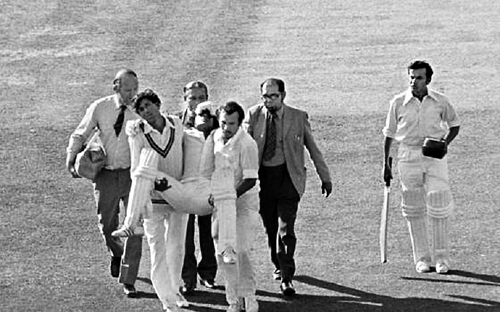Inside story of Sri Lanka’s 1975 World Cup Campaign

Duleep Mendis being carried out of the ground
Fifteen players and another four – the latter at board expense. A Head Coach, a bowling coach, a Fielding Coach, a Computer Analyst, Physiotherapist – the list in seemingly endless.
Let’s travel back in time to the inaugural World Cup in England in 1975 when professionalism was almost a dirty word in Sri Lankan cricket, the Sunday Times button-holed Sri Lanka’s first ever World Cup skipper Anura Tennekoon and Ranjit Fernando. The latter performed a dual role as opening batsman and wicketkeeper. What they said provides a lot of food for thought.
Sri Lanka entered the prestigious event as an invitee, alongside East Africa. They joined the then Test-playing countries – England, Australia, India, Pakistan, New Zealand and the West Indies in an eight-team tournament. Prior to departure, they had a ten day training programme at Radella, which was supervised by the late Bertie Wijesinghe who was recognised as one of the best in the business. Wing Commander Raja Wickremasinghe was entrusted with the task of licking the guys into shape.
The squad consisted of only 14 – Anura Tennekoon, his deputy Michael Tissera, Ranjit Fernando, Bandula Warnapura, Sunil Wettimuny, David Heyn, Mevan Pieris, Tony Opatha, Dennis Chanmugam, D.S. de Silva, Ajith de Silva, Lalith Kaluperuma, Duleep Mendis and Anura Ranasinghe.
To continue the tale of woe, the team had no coach accompanying them. As Ian Chappell was to say later, “the only coach they had was the one they travelled in from hotel to ground”. In the immediate period prior to the Big Event, they had played only four or five internationals. Before the tournament finally started, Sri Lanka had literally to fend for themselves. They were accommodated in a school hostel. They took on a few club sides. Millhill CC, the Club Cricket Conference etc. Certainly, this was no preparation for the rigourous tournament ahead.
Came the first game at Old Trafford. Tennekoon, who lost the toss, was confronted by cold, overcast conditions and a pitch that was a green top. Someone did say sotto voce that Lloyd, who was part of the Lancashire setup, had whispered in the groundsman’s ear!
The upshot of it was that the Sri Lankan’s were shot out for 85 against an attack comprising Bernard Julien, Andy Roberts, Vanburn Holder and Keith Boyce. Roy Fredricks Gordon Greenidge and Alvin Kallicharan, took the eventual champs to victory soon enough. He did, and the ball disappeared many a mile.
Next up, Australia who were not exactly quaking in their boots. They did pass 330, and a gallant, courageous Sri Lankan side made 280 plus for five wickets. Fernando and Warnapura entered the twenties, but Mendis and Wettimuny – one, a mauler, the other, a smooth-stroker, made fifties. At 150 for 2, the Sri Lankans were threatening mayhem. At this point skipper Ian Chappell must have suggested to pace-ace, Jeff Thomson to turn it on. Mendis was struck on the head and rushed to hospital. Not long after, Wettimuny, who was struck on the instep, followed him.
There was admiration all round for the Sri Lankan batting that was up against Lillee, Thomson, Gary Gilmour, Max Walker and off spinner Ashley Mallett. Zeroes one day, heros a few days later. What caused the transformation? Both Tennekoon and Fernando point to a drastic change in the conditions. The sun shone, the track was ideal for batting. Tissera got past fifty, and the skipper 48; both were unbeaten.
There must have been a touch of over confidence because Pakistan bettered the Sri Lankan team by a massive 192 runs in the next game at Trent Bridge. The stars of the previous show – Mendis and Wettimuny – did not play, and the Sri Lankans were brought down to earth with a bump.


